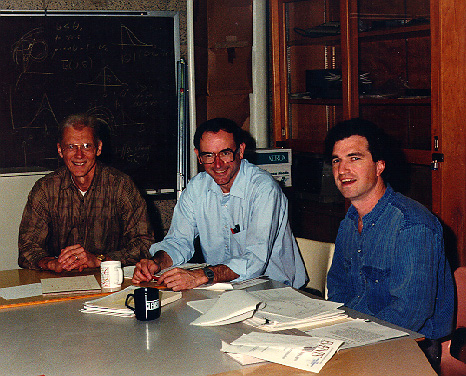


Donald Clayton, James D. Kurfess and Mark Leising at work on the discovery of radioactive 57Co in the young supernova 1987A remnant. In the Clemson Astrophysics Library on April 3, 1992, two months prior to the submission of their papers to ApJL 399, L137 and 399, L141 (1992). 57Co was the second radioactive nucleus observed in SN1987A by its gamma-ray line emission, in this case at 122 keV. This was just barely possible four years after the event (when most of the observations were made) because of the 270d halflife. Both the prediction of the observability of this line and the prediction that velocity mixing might cause early emergence of radioactive spectra were by Clayton (1974 ApJ 188, 155). The modest mass of 57Co observed contradicted then current ideas that 57Co was powering the bolometric luminosity of SN87A. After his Rice U Ph.D with Clayton, Leising participated in the discovery of 56Co in SN1987A while at NRL, and became an OSSE team member on Compton GRO, of which experiment Kurfess is Principal Investigator and Clayton is Co-Investigator. Leising then joined Clayton on the Clemson faculty, and appears in many photos on this site. Another photo of Kurfess and Clayton can be seen at the first Compton Symposium (1992) on this site, and at the 1999 Ringberg Workshop on Astronomy with Radioactivities, also on this site.

These pages are maintained by the Astrophysics Group at Clemson University.
Department of Physics and Astronomy © 1999. All rights reserved.